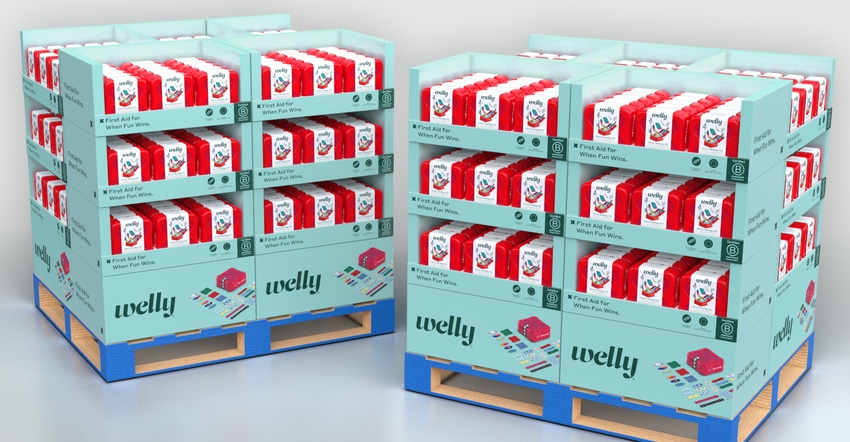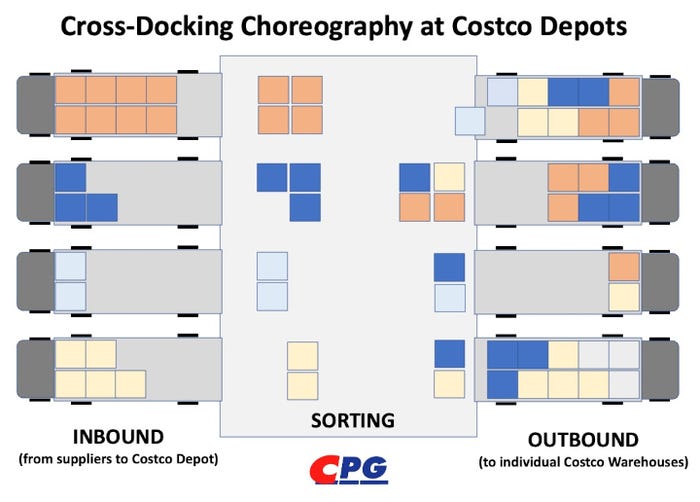Follow Costco’s 5 x 5 Rule for creating great club store packaging designs and see your product sales soar.

$5.00 chicken. Bag of russet potatoes. 2% Organic milk. 24-pack Grade AA Large Eggs, French milled Goat Milk Soap from Australia (French or Australian? No idea, love this stuff), 2-pack 100% whole wheat bread.
That’s my list. This is a quick trip. Basics. Stick to it, Michael. You got this.
$425.76 later, I find myself shuffling in a quick-moving queue of folks holding receipts, all longer than my forearm, waiting to be artfully branded by the friendliest of gentlemen. The Costco house always wins. Every. Single. Time.
Now, as a professional who has dedicated his career to the understanding of Costco, I'm not here to talk to you about how this is no accident. From the placement of those delectable rotisserie chickens to the rotating stock, the $1.50 hot dogs and Coke, the location of the aisles and locations of their carefully curated offerings.
I’m here to talk about how packaging, your packaging, is a cornerstone of success. The decisions you make with layout, print, callouts, materials, and aesthetic will make-or-break your one shot. The one shot your brand has to be a part of the incredibly limited offering within the stark walls of Costco.
We didn’t make up this rule, but we live it in every packaging design decision we make.
The 5 x 5 Rule of Costco Packaging is this: In 5 seconds from 5 feet away, does your packaging tell shoppers what the product is, and why they want it?
Insight into the 5 x 5 Rule.
Costco is a treasure hunt shopping experience.
The Treasure Hunt is so much a part of the formula that in 2021 Costco began selling a 1,000-piece jigsaw puzzle from Dowdle Studios titled "The Treasure Hunt," and — you guessed it — it depicts a packed Costco in all its glory: rotisserie chickens, free samples, massive hot dogs, and members steering their double-wide carts through the crowded aisles.
So how does a brand stand out, grab attention, and communicate value in this unique environment?
A Nielsen report from 2015 says the average consumer spends 13 seconds purchasing a brand in-store; we say you’ve got five seconds. Five seconds to communicate what your item is and why the member wants it.
How is that communicated? Packaging.
Thankfully, we control how impactful our packaging is for Costco and its members. For starters, we are shipping our actual shelf right to the store!! Think about that. The product leaves our facility and isn’t broken down, stocked, or even touched until it's sitting on the floor. We have a story to tell and brand owners, in Costco, have the luxury of telling the exact story we need to communicate member value.
So how do we achieve this? Through effective and high-design packaging that follow these five elements of 5 x 5 packaging:
1. Structural “compliance”
2. Shoppability “in environment”
3. Striking “product presentation as hero”
4. Statements “show member value”
5. Sustainability “across materials”
Let’s look at each element separately.
1. Structural “compliance.”
Before a member even has five seconds to consider your item – you have to get it there. Your item, regardless of how its value-packed persona is presented, needs to survive the choreography of the Costco cross dock.

Cross-docking involves the unloading from an inbound truck (at consolidation points; depots, in Costco lingo) and loading these materials directly into outbound trucks with little or no storage in between.
Costco has aligned its core business model to optimize this tremendous supply chain efficiency. Arguably all dry goods coming in the door are cubed out onto a full 40 x 48-inch block pallet. No overhang, minimal underhang. Few deviations. No half-pallets, end caps, PDQs, or master cases. Sidekicks? Not here. We are shipping ready-to-go Feature Pallet Displays. And, with minimal on-floor removal of ancillary shipping materials, we just shipped in our store shelves.
This process requires a tremendous amount of structural packaging expertise and ingenuity. Yes, there are ISTA (International Safe Transit Association) tests a brand can do to gain confidence, but these were designed for palletized loads; not pallet displays. Knowing this supply chain is essential to getting your finished display on the Costco floor exactly as you intended.
2. Shoppability “in environment.”
Our store shelf system survived the Cross Dock and we’ve made it to the Club floor.
What's next? Shoppability. With the countless ways to organize product on a pallet, it's important to consider the planogram-less, rotating aisles of Costco. How are we using our shelves to our advantage?
This is where the TSS (three-side-shoppable) pallet display reigns supreme (see photo above). Endcap, no problem. Under the steel, it looks great.
Costco’s primary merchandising face is the 48-inch side of the pallet. A TSS pallet simply means product is merchandised, and can be easily shopped, from three sides of the pallet. Primary 48-inch side + both 40-inch sides. This allows for a flexible and premium shopping experience from any angle.
3. Striking “present your product as the hero.”
Nothing says what your product is and why the member wants it like, well, your product.
Don't stack your offerings and hide items behind each other. Lay things out side-by-side so the member can see what they are getting from a distance. While that 4-pack of disinfecting wipe tubs may maximize the pallet best bundled as a perfect cube, in Club you want to lay them out in a perfect row of four.
Large format Club Cards (aka Trap Cards, aka Blister Cards) are so successful in Club because they create a billboard, with your product eye level and visible. Maximize the number of facings on the primary side of the pallet and don't hide behind the Tray lip.
Color blocking is huge in Club, and it's no secret why. You need to be seen to be shopped. Draw your customer in with clear messaging and once they touch — they buy.
Color blocking is huge in Club, and it's no secret why. You need to be seen to be shopped.
4. Statements “show member value.”
You are understandably proud of your brand. You spend big bucks on marketing campaigns, social media, and efforts to boost brand awareness. This is necessary in the sea of 125,000 items at your local Walmart. Not so much here.
Here, we need to step into the zone of product scarcity, treasure-hunt shopping, and expansive (ever-changing) aisles of feature pallet displays.
We do have one thing on our side: the Product TRAY. Yes! Those shelves we had the luxury of designing and shipping in. This humble chunk of eco-friendly corrugated is the backbone of Costco. Serving as shipping medium, store shelf, “grocery bag,” and (wait for it) salesperson.
We see too many brands forget about this ultra-powerful communicator that no other retail channel embraces (or needs). This massive billboard is the perfect place for an effective Value Statement.
Here are the four components of a Value Statement:
Clear: Bold messaging that differentiates and describes your product in the fewest number of words possible.
Font: A large font in a contrasting color that leaps off the print.
Solid: A solid background with no overlapping logos or cute embellishments.
Minimal: Logos are not value statements. Let's get our members’ eyes up to the product as quickly as possible — the Brand is not the Product.
A powerful Value Statement is the centerpiece of your feature pallet display in Costco. Use this tool wisely and your sales velocity will thank you. Best of all, it's free.
A powerful Value Statement is the centerpiece of your feature pallet display in Costco. Use this tool wisely and your sales velocity will thank you. Best of all, it's free.
5. Sustainability “across materials.”
Get on board. Costco is continuing to take sustainability seriously — and packaging is an area of business where Costco recognizes that continuous improvement is needed. Costco breaks its sustainability efforts down into four packaging strategies:
• Reduce the amount of packaging overall.
Less plastic and recycled content is easy. Think about right sizing your Club Card or Unit Box to work with your Tray and cube out your Display. Nothing is worse than driving a poorly sized product into a perfect Feature Pallet cube.
• Increase the recycled content and certified fiber in packaging.
Whenever possible, fiber used for paper-based packaging should come from known sources, should be procured from well-managed forests, and should not contribute to deforestation. Sustainable Forestry Initiative (SFI) and Forest Stewardship Council (FSC) are the leaders to be sure fiber-based packaging is sourced from responsibly managed and certified forests
• Increase the recyclability and/or compostability of packaging.
In today's environment there is no reason domestically sourced corrugate material is anything less than 80% recycled. All plastic used needs to be polyethylene terephthalate (PET) because it's the most widely recycled plastic and in top demand as recycled content.
• Educate and learn from employees, suppliers, and members the importance of sustainable packaging and recycling.
How2Recycle labels are the best way to educate members on the recyclability of our packaging.
With a cross-dock supply chain, low stock-keeping unit (SKU) count, and unique in-store merchandising, Costco offers great influence and impact. Do things right and your sales and marketing teams will thank you.
We like to say, all Costco programs are home runs. You only get one chance. Swing for the fences!
About the Author(s)
You May Also Like




